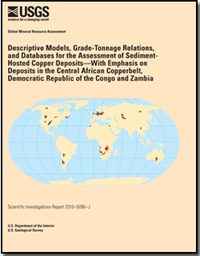Descriptive models, grade-tonnage relations, and databases for the assessment of sediment-hosted copper deposits: with emphasis on deposits in the Central Africa Copperbelt, Democratic Republic of the Congo and Zambia: Chapter J in Global mineral resource assessment
Links
- More information: USGS Index Page
- Document: Report (20.1 MB pdf)
- Larger Work: This publication is Chapter J of Global mineral resource assessment
- Appendixes:
- Companion File: Table 2-1 (0.1 MB xlsx)
- Download citation as: RIS | Dublin Core
Abstract
The Central African Copperbelt (CACB) is one of the most important copper-producing regions of the world. The majority of copper produced in Africa comes from this region defined by the Neoproterozoic Katanga sedimentary basin of the southern Democratic Republic of the Congo (DRC) and northern Zambia. Copper in the CACB is mined from sediment-hosted stratabound copper deposits associated with red beds and includes the giant deposits in the Kolwezi and Tenge-Fungurume districts in the DRC and the Konkola-Musoshi and Nchanga-Chingola districts in Zambia. In recent years, sediment-hosted structurally controlled replacement and vein (SCRV) copper deposits, such as the giant Kansanshi deposit in Zambia have become important exploration targets in the CACB region.
In 2011, the CACB accounted for 7.2 percent of the estimated global mine production of copper. Global production of copper is principally derived from porphyry and sediment-hosted copper deposits (57 and 23 percent, respectively). Almost 50 percent of the copper known to exist in sediment-hosted deposits (past production plus identified resources) is contained in the CACB, 25 percent is contained in the Zechstein Basin of northern Europe, and the remainder is contained in an additional 29 sedimentary basins distributed around the globe.
The U.S. Geological Survey (USGS) led an assessment of undiscovered copper resources in the CACB as part of a global mineral resource assessment for undiscovered resources of potash, copper, and platinum-group elements in selected mineral deposit types. As part of the assessment process, available data for the CACB were compiled and evaluated. This report describes the results of that work, including new descriptive mineral-deposit and grade and tonnage models and spatial databases for deposits and occurrences, ore bodies and open pits.
Chapter 1 of this report summarizes a descriptive model of sediment-hosted stratabound copper deposits. General characteristics and subtypes of sediment-hosted stratabound copper deposits are described based upon worldwide examples. Chapter 2 provides a global database of 170 sediment-hosted copper deposits, along with a statistical evaluation of grade and tonnage data for stratabound deposits, a comparison of stratabound deposits in the CACB with those found elsewhere, a discussion of the distinctive characteristics of the subtypes of sediment-hosted copper deposits that occur within the CACB, and guidelines for using grade and tonnage distributions for assessment of undiscovered resources in sediment-hosted stratabound deposits in the CACB. Chapter 3 presents a new descriptive model of sediment-hosted structurally controlled replacement and vein (SCRV) copper deposits with descriptions of individual deposits of this type in the CACB and elsewhere. Appendix A describes a relational database of tonnage, grade, and other information for more than 100 sediment-hosted copper deposits in the CACB. These data are used to calculate the pre-mining mineral endowment for individual deposits in the CACB and serve as the basis for the grade and tonnage models presented in chapter 2. Appendix B describes three spatial databases (Esri shapefiles) for (1) point locations of more than 500 sediment-hosted copper deposits and prospects, (2) projected surface extent of 86 selected copper ore bodies, and (3) areal extent of 77 open pits, all within the CACB.
Study Area
| Publication type | Report |
|---|---|
| Publication Subtype | USGS Numbered Series |
| Title | Descriptive models, grade-tonnage relations, and databases for the assessment of sediment-hosted copper deposits: with emphasis on deposits in the Central Africa Copperbelt, Democratic Republic of the Congo and Zambia: Chapter J in Global mineral resource assessment |
| Series title | Scientific Investigations Report |
| Series number | 2010-5090 |
| Chapter | J |
| DOI | 10.3133/sir20105090J |
| Year Published | 2013 |
| Language | English |
| Publisher | U.S. Geological Survey |
| Publisher location | Reston, VA |
| Contributing office(s) | Mineral Resources Program |
| Description | Report: xiv, 154 p.; Table 2-1; Appendixes A and B |
| Larger Work Type | Report |
| Larger Work Subtype | USGS Numbered Series |
| Larger Work Title | Global mineral resource assessment (Scientific Investigations Report 2010-5090) |
| First page | i |
| Last page | 154 |
| Country | Democratic Republic of the Congo, Zambia |
| Online Only (Y/N) | Y |
| Additional Online Files (Y/N) | Y |


